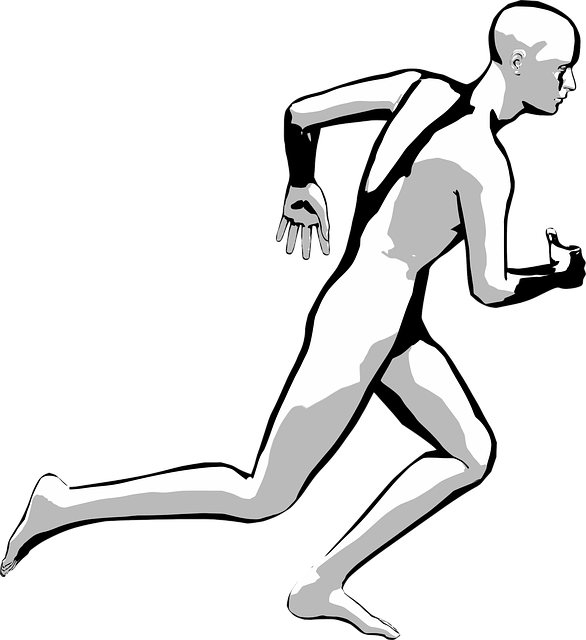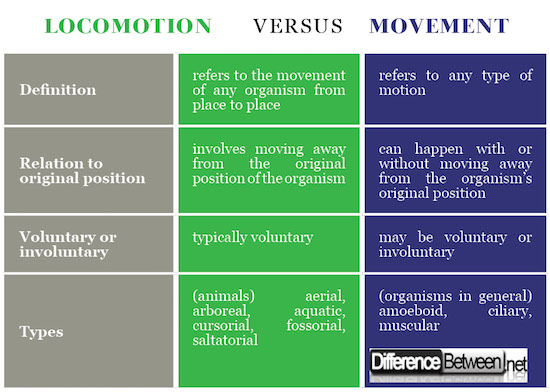Difference between Locomotion and Movement
Locomotion and movement are two important terms you are likely to encounter on the subject of motion. They come from the same basic assumption, but there are key differences between these two words.

What is Locomotion?
Locomotion refers to the movement of any organism from place to place. To move from one place to another, humans or any organism walk, run, swim, or fly using various body parts (legs and feet, fins and tail, wings, and others). Humans, however, also make use of transportation, such as cars, boats, and aircrafts to go from one place to another.
What is Movement?
Movement, on the other hand, refers to any type of motion. It can take place at any level: atomic, cellular, or within an organ. In addition, movement can be voluntary or involuntary. Clapping your hands is an example of a voluntary movement while breathing is an example of movement that is involuntary. Based on the definition of movement, locomotion is one of its examples.
Relation to Original Position
Locomotion involves moving away from the original position of the organism.
Movement can happen with or without moving away from the organism’s original position.
Voluntary or Involuntary
Locomotion is typically a voluntary movement.
Movement can be either voluntary or involuntary.

Types of Locomotion and Movement
Locomotion in animals can fall under the following broad types:
- Aerial (flying)
- Arboreal (living in and moving through trees)
- Aquatic (moving on water)
- Cursorial (running)
- Fossorial (digging and living underground)
- Saltatorial (jumping or hopping)
Movement, on the other hand, implies the following basic mechanisms:
- Amoeboid (in amoeba and certain cells in other organisms, such as the movement of leucocytes in the blood of humans)
- Ciliary (in ciliated protozoans)
- Muscular (in most vertebrates, which includes the types of locomotion cited above)
Locomotion and Movement in Plants
Plants do not usually move from place to place. Thus, they do not exhibit locomotion. However, different types of movements can occur inside plants. Plants can also demonstrate movement in response to stimuli.
Summary of difference between between Locomotion and Movement:

Both movement and locomotion are necessary for an organism to survive. Locomotion allows an organism to escape from predators, avoid harsh weather conditions, find food, and others. Movement, on the other hand, allows an organism to perform necessary functions, such as breathing, digestion, pumping of blood to the different parts of the body, and others.
- Difference Between Snowstorm and Blizzard - December 18, 2018
- Difference Between Foreword and Preface - October 4, 2018
- Difference Between Shade and Shadow - October 3, 2018
Search DifferenceBetween.net :
Leave a Response
References :
[0]Image credit: https://pixabay.com/en/running-man-movement-person-avatar-2029349/
[1]Image credit: https://upload.wikimedia.org/wikipedia/commons/thumb/8/88/Animal_Locomotion._An_Electro-Photographic_Investigation_of_Consecutive_Phases_of_Animal_Movements._Commenced_1872_-_Completed_1885._Volume_V%2C_Man_%28Pelvis_Cloth%29_MET_DP275120.jpg/640px-thumbnail.jpg
[2]Wikipedia contributors. "Animal locomotion." Wikipedia, The Free Encyclopedia. Wikipedia, The Free Encyclopedia, 4 Dec. 2017. Web. 24 Jan. 2018
[3]Contributor. “Difference between Locomotion and Movement.” Step by Step Guide to Everything. Web. 24 Jan. 2018
[4]A. Kumar. “Movement and Locomotion in Animals.” Discovery Publishing House, 2003
